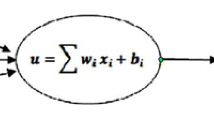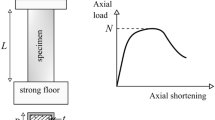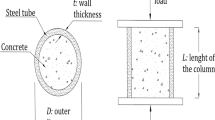Abstract
Design of rectangular concrete-filled steel tubular (CFT) columns has been a big concern owing to their complex constraint mechanism. Generally, most existing methods are based on simplified mechanical model with limited experimental data, which is not reliable under many conditions, e.g., columns using high strength materials. Artificial neural network (ANN) models have shown the effectiveness to solve complex problems in many areas of civil engineering in recent years. In this paper, ANN models were employed to predict the axial bearing capacity of rectangular CFT columns based on the experimental data. 305 experimental data from articles were collected, and 275 experimental samples were chosen to train the ANN models while 30 experimental samples were used for testing. Based on the comparison among different models, artificial neural network model1 (ANN1) and artificial neural network model2 (ANN2) with a 20-neuron hidden layer were chosen as the fit prediction models. ANN1 has five inputs: the length (D) and width (B) of cross section, the thickness of steel (t), the yield strength of steel (f y), the cylinder strength of concrete (f′c). ANN2 has ten inputs: D, B, t, f y, f′c, the length to width ratio (D/B), the length to thickness ratio (D/t), the width to thickness ratio (B/t), restraint coefficient (ξ), the steel ratio (α). The axial bearing capacity is the output data for both models.The outputs from ANN1 and ANN2 were verified and compared with those from EC4, ACI, GJB4142 and AISC360-10. The results show that the implemented models have good prediction and generalization capacity. Parametric study was conducted using ANN1 and ANN2 which indicates that effect law of basic parameters of columns on the axial bearing capacity of rectangular CFT columns differs from design codes.The results also provide convincing design reference to rectangular CFT columns.
Similar content being viewed by others
References
Han L-H, Li W, Bjorhovde R. Developments and advanced applications of concrete-filled steel tubular (CFST) structures: members. Journal of Constructional Steel Research, 2014, 100: 211–228
Eurocode 4. Design of composite steel and concrete structures, Part 1.1. General rules and rules for buildings. EN 1994–1-1. British Standards Institution, 2004
ACI 318–05. Building code requirements for structural concrete and commentary. Detroi: American Concrete Institute, 2005
GJB4142-2000. Technical specifications for early-strength model composite structures. 2001 (in Chinese)
DBJ/T13-51-2010. Technical specifications for concrete-filled steel tubular structures revised version. Fuzhou: The Housing and Urban–Rural Development Department of Fujian Province, 2010
AIJ. Recommendations for design and construction of concrete filled steel tubular structures. Tokyo: Architectural Institute of Japan (AIJ), 2008
DB29-57-2003. Technical specification for design of steel structure dwelling houses. Tianjin: Tianjin Urban & Rural Construction Commission, 2010
ANSI/AISC 360–10. Specification for structural steel buildings. Chicago: American Institute of Steel Construction (AISC), 2010
CECS 159: 2004. Technical specification for structures with concretefilled rectangular steel tube members. Beijing: China Association for Engineering Construction, 2004
Ma X B, Zhang S M. Comparison of design methods of load-carrying capacity for circular concrete-filled steel tube beam columns in typical codes worldwide. Journal of Harbin Institute of Technology, 2007, 39(4): 536–541
Dahou Z, Sbartaï Z M, Castel A, Ghomari F. Artificial neural network model for steel-concrete bond prediction. Engineering Structures, 2009, 31(8): 1724–1733
Golafshani E M, Rahai A, Sebt M H, Akbarpour H. Prediction of bond strength of spliced steel bars in concrete using artificial neural network and fuzzy logic. Construction and Building Materials, 2012, 36: 411–418
Gholizadeh S, Pirmoz A, Attarnejad R. Assessment of load carrying capacity of castellated steel beams by neural networks. Journal of Constructional Steel Research, 2011, 67(5): 770–779
Wang H J, Zhu H B, Wei H. Bearing capacity of concrete filled square steel tubular columns based on neural network. Advanced Materials Research, 2012, 502: 193–197
Zhu M C, Wang Q X, Feng X F. Prediction of axial capacity of concrete-filled square steel tubes using neural networks. Journal of Southeast Jiaotong University, 2005, 13(2): 151–156
Han L-H. Tests on stub columns of concrete-filled RHS sections. Journal of Constructional Steel Research, 2002, 58: 355–372
Shakir-Khalil H, Zeghiche J. Experimental behavior of concrete filled rolled rectangular hollow-section columns. Structural Engineer, 1989, 67(19): 346–353
Shakir-Khalil H, Mouli M. Further tests on concrete-filled rectangular hollow-section columns. Structural Engineer, 1990, 68(20): 405–413
Sakino K, Nakahara H, Morino S, Nishiyama I. Behavior of centrally loaded concrete-filled steel-tube short columns. Journal of Structural Engineering, 2004, 130(2): 180–188
Liu D, Gho W-M. Axial load behaviour of high-strength rectangular concrete-filled steel tubular stub columns. Thin-Walled Structures, 2005, 43(8): 1131–1142
Zhang S M, Guo L H, Ye Z L, Wang Y Y. Experimental research on high strength concrete-filled SHS stub columns subjected to axial compressive load. Journal of Harbin Institute of Technology, 2004, 36(12): 1610–1614
Guo L-H, Zhang S-M. Influence of side-length ratio on high strength concrete-filled RHS tube subjected to axial loading. Journal of Harbin Institute of Technology, 2003, 35(Suppl): 155–159
Uy B. Strength of short concrete filled high strength steel box columns. Journal of Constructional Steel Research, 2001, 57(2): 113–134
Uy B. Strength of concrete filled steel box columns incorporating local buckling. Journal of Structural Engineering, 2000, 126(3): 341–352
Liu D, Gho W-M, Yuan J. Ultimate capacity of high-strength rectangular concrete-filled steel hollow section stub columns. Journal of Constructional Steel Research, 2003, 59(12): 1499–1515
Liu D. Tests on high-strength rectangular concrete-filled steel hollow section stub columns. Journal of Constructional Steel Research, 2005, 61(6): 902–911
Han L-H, Zhao X-L, Tao Z. Tests and mechanics model for concretefilled SHS stub columns, columns and beam-columns. Steel and Composite Structures, 2001, 1(1): 51–74
Schneider S P. Axially loaded concrete-filled steel tubes. Journal of Structural Engineering, 1998, 124(10): 1125–1138
Yao G. Research on behavior of concrete-filled steel tubes subjected to complicated loading status. Dissertation for the Doctoral Degree. Fuzhou: Fuzhou University, 2006, 27–56
Tao Z, Han L-H, Wang Z-B. Experimental behaviour of stiffened concrete-filled thin-walled hollow steel structural (HSS) stub columns. Journal of Constructional Steel Research, 2005, 61(6): 962–983
Tao Z, Han L-H, Wang D-Y. Strength and ductility of stiffened thinwalled hollow steel structural stub columns filled with concrete. Thin-Walled Structures, 2008, 46(10): 1113–1128
Chen C-C, Ko J-W, Huang G-L, Chang Y-M. Local buckling and concrete confinement of concrete-filled box columns under axial load. Journal of Constructional Steel Research, 2012, 78: 8–21
Liew J Y R, Xiong D X, Zhang M H. Experimental studies on concrete filled tubes with ultra-high strength materials. In: Proceedings of the 6th International Symposium on Steel Structures. 2011, 377–384
Lam D, Williams C A. Experimental study on concrete filled square hollow sections. Steel and Composite Structures, 2004, 4(2): 95–112
Dreyfus G, Martinez J M, Samuelides M, Gordon M B, Badran F, Thiria S, Hérault L. Réseaux de neurones-Méthodologieet applications. Eyrolles, 2002
Caglar N. Neural network based approach for determining the shear strength of circular reinforced concrete columns. Construction and Building Materials, 2009, 23(10): 3225–3232
Rumelhart D E, Hinton G E, Williams R J. Learning internal representations by error propagation. In: Rumelhart D E, McClelland J L, eds. Parallel Distributed Processing, Vol 1. Cambridge, MA: MIT Press, 1987
Wen X Z, Shao L, Xue Y, Fang W. A rapid learning algorithm for vehicle classification. Information Sciences, 2015, 29(1): 395–406
Xie S D, Wang Y X. Construction of tree network with limited delivery latency in homogeneous wireless sensor networks. Wireless Personal Communications, 2014, 78(1): 231–246
Marquardt DW. An algorithm for least-squares estimation of nonlinear parameters. Journal of The Society for Industrial and Applied Mathematics, 1963, 11(2): 431–441
Acknowledgements
This work was sponsored by the National Natural Science Foundation of China (Grant No. 61272264).
Author information
Authors and Affiliations
Corresponding author
Additional information
Yansheng Du received his BE degree in civil engineering from Tianjin University (TJU), China in 2012. He is now a PhD student in the School of Civil Engineering, TJU, and a visiting scholar of the Department of Civil and Environmental Engineering, National University of Singapore, Singapore. His research interests include steelconcrete composite structures and the applications of soft computing methods in civil engineering.
Zhihua Chen received his BE, ME, and PhD degrees from Tianjin University (TJU), China. He is now a professor of the School of Civil Engineering, TJU. His main research interests include the steel structures, the composite structures and the large-span structures. He has authored or co-authored over 150 journal and conference papers. He is the president of the Tianjin Steel Construction Society and the committee member of Chinese National Engineering Research Center for Steel Structures.
Changqing Zhang received the BS and ME degrees in computer science from Sichuan University, China in 2005 and 2008, and the PhD degree from Tianjin University (TJU), China in 2016, respectively. He is currently an assistant professor with TJU. His current research interests include machine learning, data mining, and computer vision.
Xiaochun Cao received the BE and ME degrees in computer science from Beihang University, China, and the PhD degree in computer science from the University of Central Florida, USA, with his dissertation nominated for the university level Outstanding Dissertation Award. From 2008 to 2012, he was a professor at Tianjin University, China. He is currently a Professor with the Institute of Information Engineering, Chinese Academy of Sciences, China. He has authored or co-authored over 100 journal and conference papers. He was the recipients of the Piero Zamperoni Best Student Paper Award at the International Conference on Pattern Recognition in 2004 and 2010. He is a fellow of the IET. He is also an associate editor of the IEEE Transactions on Image Processing.
Electronic supplementary material
Rights and permissions
About this article
Cite this article
Du, Y., Chen, Z., Zhang, C. et al. Research on axial bearing capacity of rectangular concrete-filled steel tubular columns based on artificial neural networks. Front. Comput. Sci. 11, 863–873 (2017). https://doi.org/10.1007/s11704-016-5113-6
Received:
Accepted:
Published:
Issue Date:
DOI: https://doi.org/10.1007/s11704-016-5113-6




